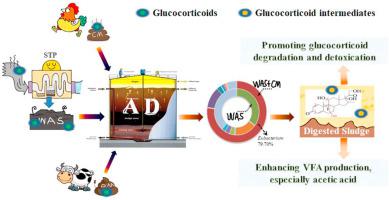Environmental Research ( IF 8.3 ) Pub Date : 2021-06-19 , DOI: 10.1016/j.envres.2021.111488 Ai Zhang 1 , Jinling He 2 , Yuye Shen 2 , Xianbao Xu 2 , Yanan Liu 1 , Yongmei Li 3 , Shimin Wu 4 , Gang Xue 2 , Xiang Li 1 , Jacek Makinia 5

|
Waste activated sludge (WAS) and animal manure are two significant reservoirs of glucocorticoids (GCs) in the environment. However, GC degradation during anaerobic digestion (AD) of WAS or animal manure has rarely been investigated. In this study, co-fermentation of WAS and animal manure was conducted to investigate the performance of AD in controlling GC dissemination. Effects of manure type on GC degradation and sludge acidification were investigated. The results showed that co-fermentation of WAS and chicken manure (CM) significantly enhanced the degradation of hydrocortisone (HC) to 99%, betamethasone (BT) to 99%, fluocinolone acetonide (FA) to 98%, and clobetasol propionate (CP) to 82% in 5 days with a mixing ratio of 1:1 (g TS sludge/g dw manure) at 55 °C and initial pH of 7. Simultaneously, sludge reduction was increased by 30% and value-added volatile fatty acid (VFA) production was improved by 40%. Even a high GC content of biomass (3.6 mg/g TS) did not impact both sludge hydrolysis and acidification. The amendment of WAS with CM increased soluble organic carbon, Ca2+, and relative abundance of anaerobes (Eubacterium) associated with organic compound degradation. Furthermore, 44 transformation products of HC, BT, FA, and CP with lower lipophilicity and toxicity were identified, indicating possible degradation pathways including hydroxylation, ketonization, ring cleavage, defluorination, hydrogenation, methylation, and de-esterification. Overall, this study provides a practical way to control GC pollution and simultaneously promote waste reduction and VFA production. Animal manure type as an overlooked factor for influencing co-fermentation performance and pollutant degradation was also highlighted.
中文翻译:

通过废活性污泥和动物粪便的共同发酵增强糖皮质激素的降解,一种潜在的 COVID-19 补救措施:粪便类型和降解机制的作用
废弃活性污泥 (WAS) 和动物粪便是环境中两个重要的糖皮质激素 (GC) 储存库。然而,很少研究 WAS 或动物粪便厌氧消化 (AD) 过程中的 GC 降解。在这项研究中,进行了 WAS 和动物粪便的共同发酵,以研究 AD 在控制 GC 传播方面的性能。研究了粪便类型对 GC 降解和污泥酸化的影响。结果表明,WAS和鸡粪(CM)的共发酵显着促进了氢化可的松(HC)的降解达99%,倍他米松(BT)的降解达99%,醋酸氟轻松(FA)的降解达98%,丙酸氯倍他索(CP) ) 在 5 天内达到 82%,混合比为 1:1(g TS 污泥/g dw 粪便),在 55 °C 和初始 pH 值为 7。同时,污泥减少量增加了 30%,增值挥发性脂肪酸 (VFA) 产量提高了 40%。即使生物质的高 GC 含量(3.6 毫克/克 TS)也不会影响污泥水解和酸化。WAS 与 CM 的改良增加了可溶性有机碳、Ca2+,以及与有机化合物降解相关的厌氧菌(真杆菌)的相对丰度。此外,还鉴定了 44 种亲脂性和毒性较低的 HC、BT、FA 和 CP 转化产物,表明可能的降解途径包括羟基化、酮化、开环、脱氟、氢化、甲基化和脱酯化。总的来说,这项研究提供了一种实用的方法来控制 GC 污染,同时促进废物减少和 VFA 生产。还强调了动物粪便类型是影响共发酵性能和污染物降解的一个被忽视的因素。


























 京公网安备 11010802027423号
京公网安备 11010802027423号